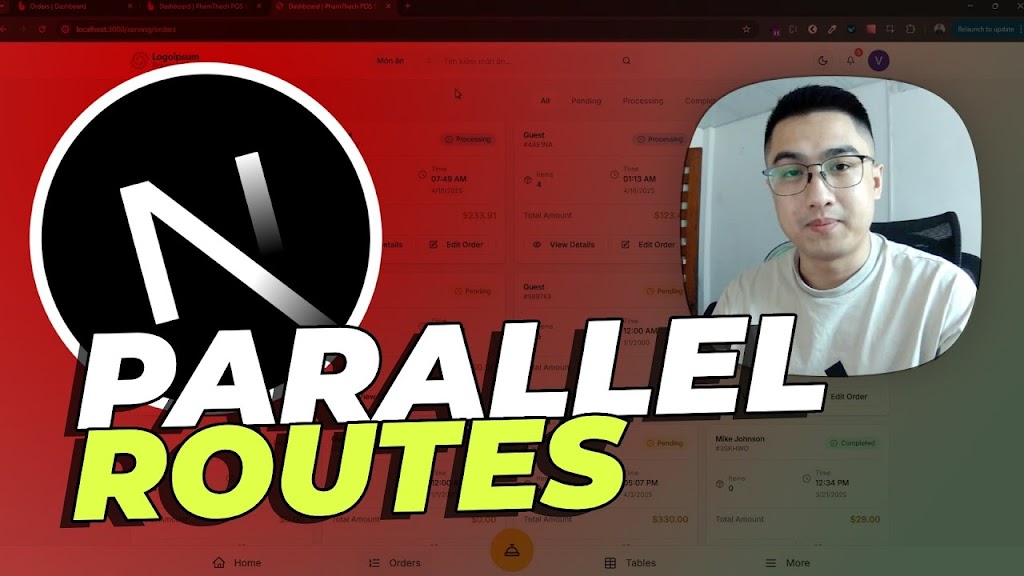Based on a tutorial by Vin Web
Are you struggling to optimize your NextJS application’s performance when loading detailed information? You’re not alone. Many developers face challenges when trying to balance speed with functionality in their web apps.
I’ve summarized this excellent tutorial to help you understand how Parallel Routing in NextJS can significantly improve your application’s performance and user experience.
Quick Navigation
Understanding Parallel Routing (00:00-03:45)
Parallel Routing in NextJS allows developers to load multiple UI components simultaneously without affecting the main URL structure. This creates a smoother user experience, especially when accessing detailed information.
Key Points:
- Parallel Routing maintains the current URL while loading new content
- It enables showing modal-like interfaces without full page refreshes
- Pronunciation note: The term may be read as “routing” or sometimes as “rooting”
My Take:
Parallel Routing is one of NextJS’s most powerful features for creating modern, responsive interfaces. It’s particularly valuable for applications where users need to quickly view details without losing context of their current page.
Real-World Examples: Facebook Implementation (03:46-06:30)
The tutorial uses Facebook as a practical example of parallel routing implementation. When you click on a video or post on Facebook, the content appears without completely changing your location in the site.
Key Points:
- The URL changes to reflect the specific content being viewed
- Clicking “back” returns to the previous view while maintaining your position
- The interface only fully resets if you perform a page refresh
- This approach creates a more seamless browsing experience
My Take:
Major platforms like Facebook have perfected this pattern because it significantly improves user retention. Users are more likely to explore content when they don’t fear losing their place in the feed.
Practical Implementation in NextJS (06:31-11:15)
The tutorial demonstrates a practical implementation of parallel routing using a serving order application. When clicking “View Detail,” a modal appears with detailed information without navigating away from the list page.
Key Points:
- Parallel routing helps optimize performance by loading only necessary data
- The list view can remain lightweight while detailed information loads separately
- When refreshing the page with an open detail view, the UI maintains the modal but might need to reload the background data
- The interface becomes much more responsive, especially with larger datasets
My Take:
This pattern is perfect for admin dashboards, e-commerce product listings, or any interface where users need to quickly scan through items while occasionally diving deeper into specific details.
Code Structure for Parallel Routing (11:16-14:00)
The tutorial explains the code structure needed to implement parallel routing in NextJS. The application is organized into components like model, add, and list, each with its own folder structure.
Key Points:
- The structure includes modal components with their own page and layout files
- The shared layout contains the model component and renders children content
- Data fetching is separated between list views and detail views for performance
- The approach requires thoughtful component organization but offers significant benefits
// Example folder structure for parallel routing
app/
├── (routes)/
│ ├── serving-order/
│ │ ├── page.tsx // Main list view
│ │ ├── layout.tsx // Layout that includes modal outlet
│ │ ├── @modal/ // Parallel route segment
│ │ │ ├── page.tsx // Default (empty) modal state
│ │ │ ├── [id]/ // Dynamic route for specific items
│ │ │ │ └── page.tsx // Detail modal content
My Take:
While the structure seems complex at first, it follows NextJS’s convention-based approach. This organization becomes intuitive once you understand how parallel routes work with the app router.
Performance Benefits and Considerations (14:01-16:30)
The video concludes by highlighting the performance benefits of parallel routing and mentioning related concepts like intercepting routes. The presenter notes that while implementing parallel routing for everything might be time-consuming, it’s worth prioritizing for key user interactions.
Key Points:
- Parallel routing significantly improves perceived performance by loading only needed data
- The approach is particularly valuable for data-heavy applications
- You can reference the official NextJS documentation at app-router.vercel.app/parallel-routes
- Related concept: Intercepting routes (mentioned but not fully explored in the tutorial)
My Take:
Strategically implementing parallel routing for your most important user flows will give you the best return on development time. Focus on data-heavy details or frequently accessed information first.
This article summarizes the excellent tutorial created by Vin Web. If you found this summary helpful, please support the creator by watching the full video and subscribing to their channel.





